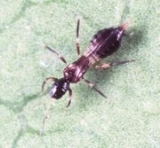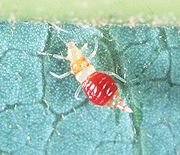
Franklinothrips
Encyclopedia
Franklinothrips is a genus of thrips
with pantropical
distribution.
in the 1930s.
 Most species are apparently bisexual (have both males and females) and occur only in small areas. An exception is F. vespiformis, which is unisexual (mostly females) and occurs in many tropical countries. Only few males were produced during rearing programmes involving F. vespiformis.
Most species are apparently bisexual (have both males and females) and occur only in small areas. An exception is F. vespiformis, which is unisexual (mostly females) and occurs in many tropical countries. Only few males were produced during rearing programmes involving F. vespiformis.
). Particularly the Africa
n species F. megalops very closely mimics ants in its behavior and body form. Males are less ant-like in appearance. They are smaller, have longer antennae and a less constricted waist.
trees. Together with F. vespiformis it has been marketed in Europe as a control agent against thrips in greenhouse
s. F. vespiformis also feeds on mite
s, nymph
s of a whitefly
species and the larvae of an agromyzid
fly. F. megalops has been used for thrips control in "internal landscapes".
The species F. megalops, F. rarosae and F. variegatus appear to part of a cline
across the Old World tropics from Africa to Australia, with F. rarosae being intermediate in appearance as well as distribution.
The only genus closely related to Franklinothrips is Corynothripoides from Africa, and its only species, C. marginipennis, could even belong to the same genus.
F. caballeroi and F. suzukii are possibly the same species, with one having been distributed through horticultural trade.
Thrips
Thrips are tiny, slender insects with fringed wings . Other common names for thrips include thunderflies, thunderbugs, storm flies, thunderblights, and corn lice...
with pantropical
Pantropical
In biogeography, a pantropical distribution one which covers tropical regions of all of the major continents, i.e. in Africa, in Asia and in the Americas. Examples include the plant genera Acacia and Bacopa....
distribution.
Name
The genus name is derived from the surname of entomologist H. J. Franklin, who described thrips taxa in the early 1900s. The thrips genus Frankliniella is also named after him. Franklin worked at the entomology department of the University of Massachusetts AmherstUniversity of Massachusetts Amherst
The University of Massachusetts Amherst is a public research and land-grant university in Amherst, Massachusetts, United States and the flagship of the University of Massachusetts system...
in the 1930s.
Reproduction

Mimicry
The fast-running females are easily misidentified as ants or bethylid wasps (superfamily ChrysidoideaChrysidoidea
The superfamily Chrysidoidea is a very large cosmopolitan group of parasitoid or cleptoparasitic wasps, with three large, common families and four tiny, rare families. Most species are small , almost never exceeding 15 mm...
). Particularly the Africa
Africa
Africa is the world's second largest and second most populous continent, after Asia. At about 30.2 million km² including adjacent islands, it covers 6% of the Earth's total surface area and 20.4% of the total land area...
n species F. megalops very closely mimics ants in its behavior and body form. Males are less ant-like in appearance. They are smaller, have longer antennae and a less constricted waist.
Feeding behavior
F. orizabensis is known to be unable to survive solely on plant food. It is used as a control agent against thrips on avocadoAvocado
The avocado is a tree native to Central Mexico, classified in the flowering plant family Lauraceae along with cinnamon, camphor and bay laurel...
trees. Together with F. vespiformis it has been marketed in Europe as a control agent against thrips in greenhouse
Greenhouse
A greenhouse is a building in which plants are grown. These structures range in size from small sheds to very large buildings...
s. F. vespiformis also feeds on mite
Mite
Mites, along with ticks, are small arthropods belonging to the subclass Acari and the class Arachnida. The scientific discipline devoted to the study of ticks and mites is called acarology.-Diversity and systematics:...
s, nymph
Nymph
A nymph in Greek mythology is a female minor nature deity typically associated with a particular location or landform. Different from gods, nymphs are generally regarded as divine spirits who animate nature, and are usually depicted as beautiful, young nubile maidens who love to dance and sing;...
s of a whitefly
Whitefly
The whiteflies, comprising only the family Aleyrodidae, are small hemipterans. More than 1550 species have been described. Whiteflies typically feed on the underside of plant leaves.-Agricultural threat:...
species and the larvae of an agromyzid
Agromyzidae
The family Agromyzidae is commonly referred to as the leaf-miner flies, for the feeding habit of larvae, most of which are leaf miners on various plants....
fly. F. megalops has been used for thrips control in "internal landscapes".
Taxonomy
The three neotropical species F. orizabensis, F. tenuicornis and F. vespiformis are closely related.The species F. megalops, F. rarosae and F. variegatus appear to part of a cline
Cline (population genetics)
In biology, an ecocline or simply cline describes an ecotone in which a series of biocommunities display continuous gradient...
across the Old World tropics from Africa to Australia, with F. rarosae being intermediate in appearance as well as distribution.
The only genus closely related to Franklinothrips is Corynothripoides from Africa, and its only species, C. marginipennis, could even belong to the same genus.
F. caballeroi and F. suzukii are possibly the same species, with one having been distributed through horticultural trade.

